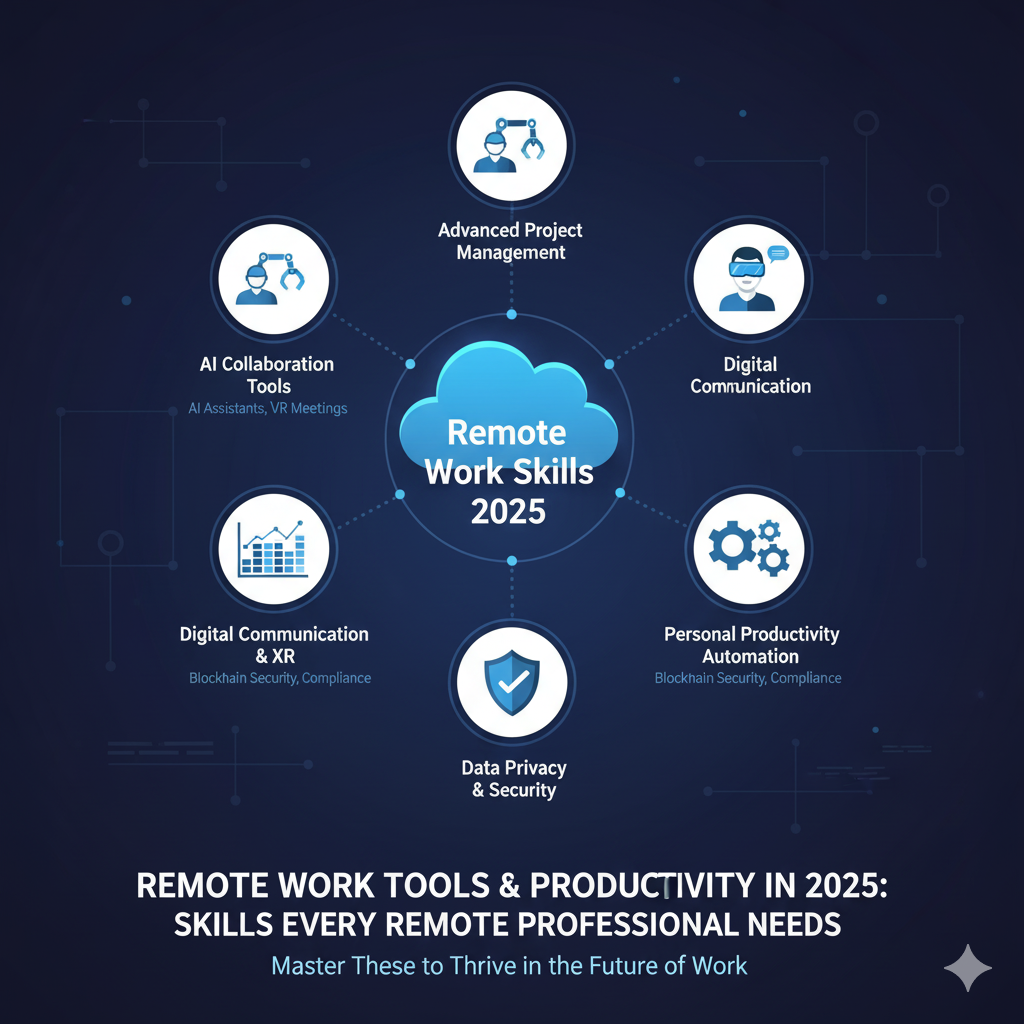
“Remote Work Tools & Productivity in 2025: Skills Every Remote Professional Needs”
Introduction
The world of work has undergone a seismic shift. As we move through 2025, remote and hybrid models are no longer emergency measures — they’re the new standard. To thrive in this environment, remote professionals must not only master digital tools but also refine workflows, time-management habits, and collaboration styles.
In this blog, we’ll explore:
the must-have tools for remote productivity
the smart workflows that enable seamless collaboration
the core skills every remote professional should develop
and how to upskill for long-term success
1. Remote Work Tools: The Foundation of ProductivityHaving the right toolkit is non-negotiable for today’s remote professionals. Here are the essential tools dominating 2025:
Communication & Collaboration ToolsPlatforms like Slack and Microsoft Teams continue to lead the way in communication and team coordination. Slack’s channel-based messaging, file sharing, and seamless integrations make it ideal for fast-paced teams, while Teams brings video meetings, documents, and collaboration into one hub.
For video calls and webinars, Zoom remains the industry favorite, offering reliable screen sharing and recording features.
Project & Task Management ToolsWhen it comes to task management, Asana and Trello are top choices. Asana helps teams assign tasks, set deadlines, and track progress through visual timelines, while Trello’s simple Kanban boards make it perfect for freelancers and small teams.
All-in-one workspaces like Notion have also become essential. Notion combines notes, databases, and project management features, giving teams a single source of truth for everything they do.
Time-Tracking & Focus ToolsTools such as Toggl Track and RescueTime are helping professionals monitor productivity and reduce distractions. Toggl is perfect for freelancers managing billable hours, while RescueTime automatically analyzes app and website usage to help users optimize focus.
Security & Access Management ToolsWith data security now a top priority, tools like LastPass and Okta ensure password safety and controlled access across teams.
2. Workflows That Enable Remote ExcellenceHaving tools is one thing; using them strategically is what separates average professionals from great ones. Here are workflow practices that drive remote success:
a) Asynchronous CommunicationSince remote teams often span multiple time zones, asynchronous (async) communication has become essential. Using Slack threads, Loom video updates, and shared Notion docs allows teammates to share updates without waiting for meetings.
b) Outcome-Oriented TrackingIn 2025, results matter more than logged hours. According to Aspinix, professionals who focus on outcomes instead of activity are more valued by employers. Use tools like Asana or Trello to track measurable deliverables rather than vague tasks.
c) Time-Blocking & Focus SessionsManaging time at home can be tricky. Techniques like Pomodoro, or scheduling “deep work” blocks on calendars, help create discipline. Nploy Resources recommends pairing these habits with apps like RescueTime to spot distractions.
d) Centralized DocumentationHaving a shared “knowledge hub” is vital. Platforms like Notion or Confluence allow teams to store decisions, meeting notes, and SOPs in one place. This ensures that no one waits for another person’s update to move forward.
e) Regular Check-InsEven in async environments, occasional live syncs — such as weekly retros or one-on-one calls — strengthen alignment and morale.
3. Skills Every Remote Professional Needs in 2025Self-Discipline & Time Management
The absence of office boundaries means you must manage yourself. Building daily routines, setting task priorities, and maintaining consistency is key. As Nploy notes, self-discipline is one of the top traits employers look for in remote professionals.
Digital Communication & CollaborationYour ability to write clear, concise messages and maintain tone across platforms defines your professional image. Jobicy emphasizes mastering written communication and familiarity with collaboration tools like Miro, Slack, and Notion.
Tech-Savviness & AdaptabilityBeing tech-savvy doesn’t mean coding — it means navigating new platforms with confidence. Remployee.io highlights adaptability as a critical advantage in 2025’s rapidly changing tool ecosystem.
Emotional Intelligence (EQ)Strong relationships drive collaboration. LPCentre identifies emotional intelligence as key for virtual empathy, trust, and positive team culture.
Accountability & OwnershipRemote work thrives on trust. Jobicy advises being transparent about progress, meeting deadlines, and being proactive — all traits of reliable remote contributors.
Continuous Learning & UpskillingWith emerging tools, AI, and hybrid models reshaping workflows, continuous learning keeps professionals ahead. Miro Scholarship recommends micro-learning and professional certifications as the best way to stay relevant.
4. Upskilling for Remote Work: Staying Ahead in 2025Here are practical steps to sharpen your skills:
Enroll in specialized online courses via LinkedIn Learning or Coursera to enhance digital collaboration and leadership skills.
Build a personal “tool-mastery roadmap” — choose one new tool (like Notion, ClickUp, or Loom) to learn every quarter.
Develop asynchronous communication habits by summarizing work progress in clear written updates.
Practice emotional intelligence during remote interactions by offering feedback, appreciation, and empathy.
Set measurable learning goals — such as completing a new certification or automating a workflow within 30 days.
5. The Future of Remote Work in 2025 & BeyondRemote work continues to evolve with powerful trends shaping its future:
AI-Powered Workflows: Automation of meeting notes, scheduling, and task management is transforming productivity, according to Miro Scholarship. VR/AR Collaboration: Teams are beginning to use immersive tools for meetings and design brainstorming, as reported by Looking for Resume. Stronger Security Practices: With remote endpoints growing, companies are adopting zero-trust and identity-management models (Looking for Resume). Outcome-Based Productivity: Organizations increasingly value impact over attendance — a principle echoed by WorkinVirtual. Work-Life Integration: Maintaining balance and mental well-being has become integral to long-term success in remote careers. 6. Putting It All Together: A Sample Remote-Professional RoutineHere’s how a productive remote-work day might look:
08:30 – Check Slack channels, review the day’s tasks in Asana or Trello
09:00-11:00 – Deep-work block: focus on one major deliverable (timer on via Toggl)
11:00 – Quick stand-up or async update: note progress, blockers, next steps
11:15-13:00 – Collaborative work: Zoom call/Teams session with stakeholders
13:00-14:00 – Lunch break + physical movement
14:00-16:00 – Knowledge-base updates: add project learnings to Notion, share with team
16:00-17:30 – Secondary tasks, respond to emails, documentation
17:30 – End-of-day check: evaluate what was done, set plan for tomorrow
By structuring your day this way (and using the workflows/tools above) you’ll not only stay productive—but also resilient and adaptive.
ConclusionRemote work in 2025 isn’t just about having a good chair and fast WiFi. It’s about mastering the tools, refining smart workflows, cultivating the right skills, and committing to continuous growth. Whether you’re an individual contributor, team leader or freelancer, the combination of tool-fluency + remote-work mindset will set you apart.
For teams, embedding the right tools (Slack, Teams, Asana, Notion), enabling async workflows, and investing in upskilling makes the difference between just “working remotely” and truly “thriving remotely”.
Ready to elevate your remote game? Start today: pick one new tool to master, block your deep-work time tomorrow, and schedule your first “remote-work skills sprint”. Your future self will thank you.
How to Build Remote-Ready Teams






